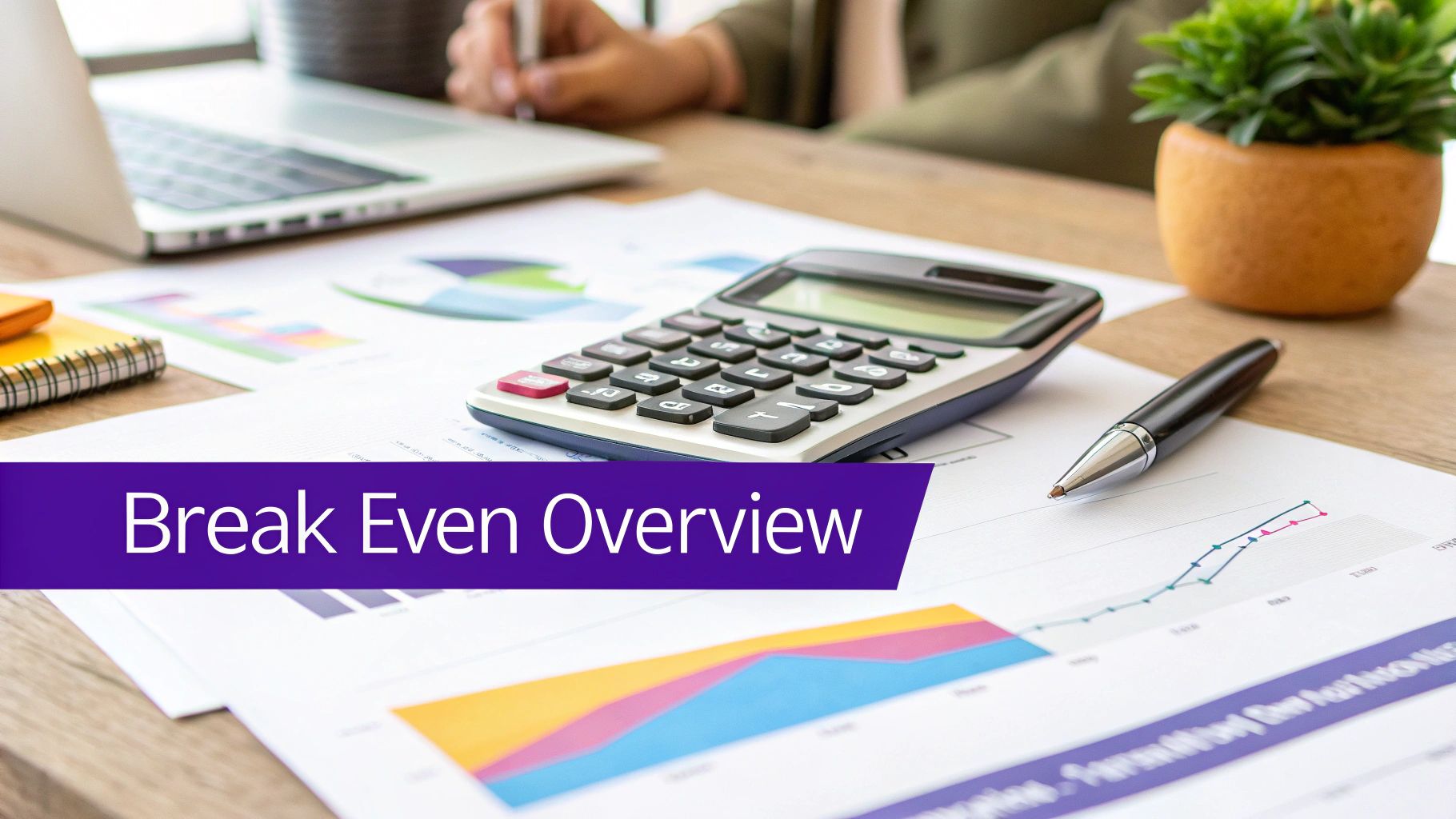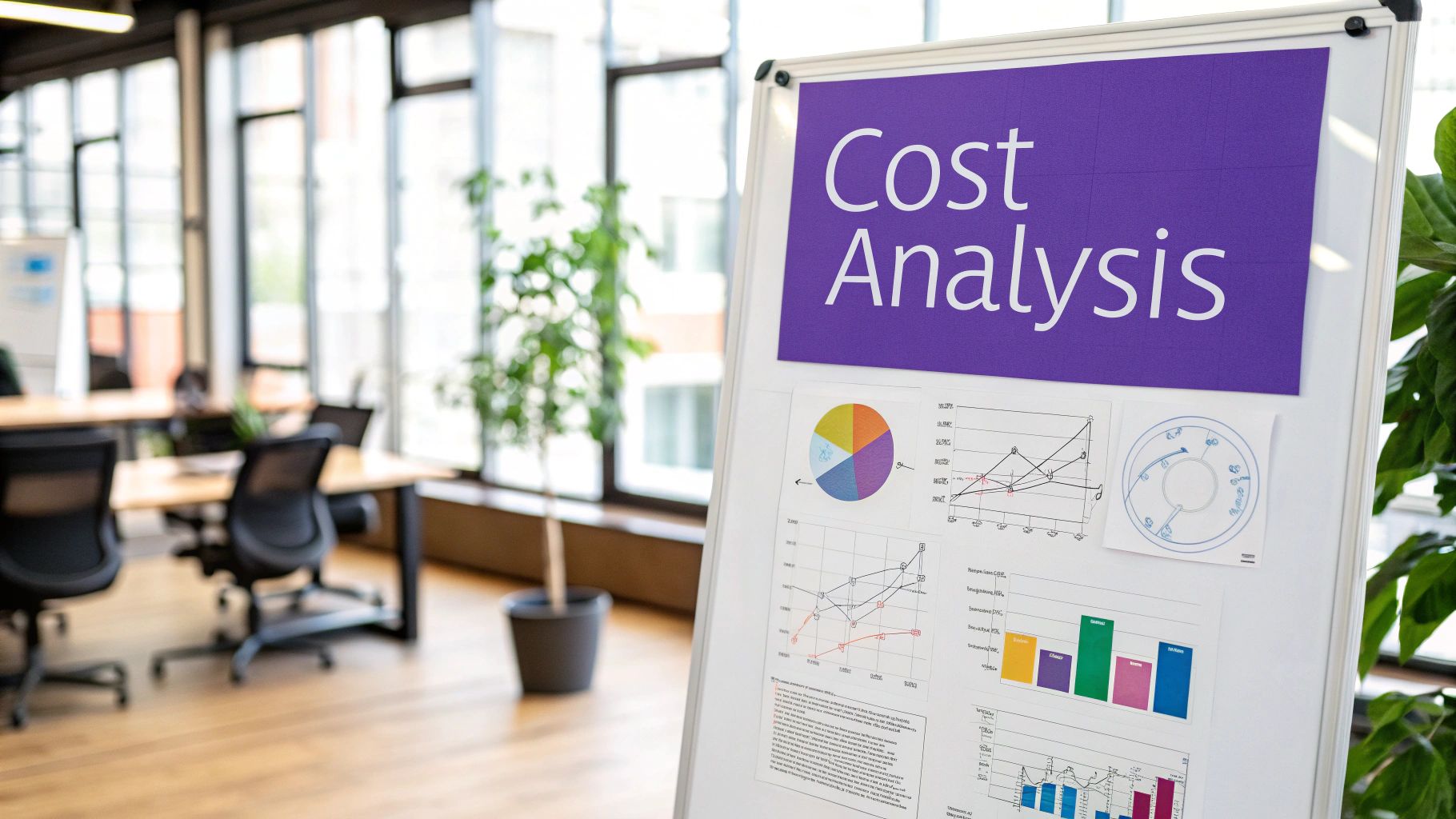How to Calculate Break Even Point: Quick Tips

The Break-Even Mindset: Why Great Businesses Master This First

Thriving businesses are built on a solid understanding of core financial principles. One of these, the break-even point, is often overlooked, but it's a vital part of strategic thinking. It marks the shift from loss to profit, the point where total revenue equals total costs. This concept helps separate sustainable ventures from those on shaky ground.
Why the Break-Even Point Matters
Knowing how to calculate your break-even point brings clarity and empowers smarter decisions. Established businesses use it to assess new ventures, fine-tune pricing, and optimize resources. For startups, it's the bedrock of a viable business plan, essential for attracting investors and securing funding. It helps determine when profitability will be reached.
For example, a company with $10,000 in monthly fixed costs and a $80 contribution margin per unit has a break-even point of 125 units. This means selling at least 125 units is needed to cover costs and start earning profit. Understanding this allows for realistic sales targets and efficient resource management. It also informs strategic decisions, like adjusting prices or cutting costs for faster profitability. Increasing the selling price or lowering variable costs can lower the break-even point, making it easier to reach profitability. Learn more about break-even points here: Wall Street Prep Break Even Point
Using Break-Even Analysis for Strategic Growth
Business leaders leverage break-even analysis to assess the viability of potential new ventures. Consider a new product launch. Calculating the break-even point reveals the sales volume required to cover development and marketing costs. This informs realistic sales goals and helps gauge potential return on investment. This data-driven approach minimizes risk and maximizes the chances of success.
Beyond the Numbers: A Mindset Shift
Mastering the break-even point is about more than just calculations; it’s a fundamental change in how you approach your business finances. It fosters financial discipline, proactive cost management, and a laser focus on profitability. This forward-thinking perspective allows businesses to navigate market fluctuations, anticipate challenges, and make strategic adjustments to stay ahead. This proactive stance not only promotes survival but also paves the way for sustainable growth and long-term success.
Building Your Break-Even Foundation: The Three Essential Elements

Before diving into calculating your break-even point, it's essential to grasp the fundamental components that make it work. These three key elements—fixed costs, variable costs, and contribution margin—form the foundation of solid financial planning for any business.
Understanding Fixed Costs
Fixed costs are those expenses that remain the same, regardless of how much you sell. Think of them as the overhead required to keep your business operating. For an e-commerce business, examples might include your monthly Shopify subscription, web hosting fees, and salaries. Accurately identifying these fixed costs is the first step in calculating your break-even point.
Variable Costs: Fluctuating With Sales
In contrast to fixed costs, variable costs change directly in proportion to your sales volume. These costs are tied to production or service delivery. For e-commerce businesses, variable costs could include the cost of goods sold (COGS), transaction fees, and shipping costs. As your sales increase, so do these expenses.
Contribution Margin: Bridging the Gap
The contribution margin represents the difference between your sales revenue and your variable costs. This important metric shows how much of each sale contributes towards covering your fixed costs and eventually, generating profit. For example, if you sell a product for $50 and your variable costs are $20, your contribution margin is $30. This $30 then goes towards covering your fixed expenses.
Identifying and Categorizing Costs: Avoiding Common Pitfalls
Correctly categorizing costs is crucial for an accurate break-even analysis. A common mistake is misclassifying semi-variable costs – expenses with both fixed and variable components. For example, customer service might have a fixed salary component and a variable component tied to call volume. Accurately separating these is key for precise calculations when determining how to calculate your break-even point.
Another common oversight is neglecting to update cost figures regularly. Costs can fluctuate, and using outdated information can lead to inaccurate break-even projections. Regularly reviewing and updating these figures keeps your analysis relevant and reliable. By understanding these core elements and avoiding common pitfalls, you’ll build a solid foundation for effective break-even analysis, enabling informed decisions about pricing, cost management, and overall business strategy.
Calculating Your Break Even Point: Methods That Actually Work

Now that we understand the basics of break-even analysis, let's dive into the actual methods used to calculate this important point. Each technique offers a slightly different perspective, giving you a well-rounded understanding of your business's financial health.
The Contribution Margin Formula: A Quick Snapshot
Need a fast way to figure out your break-even point in units? The contribution margin method is your answer! Remember, the contribution margin is the amount left over from each sale after covering variable costs. This leftover amount helps cover your fixed costs. The formula is straightforward:
Break-Even Point (Units) = Fixed Costs / Contribution Margin per Unit
Let's say your fixed costs are $5,000 per month, and your contribution margin is $25 per unit. Your break-even point is 200 units. This means you need to sell 200 units just to cover your fixed costs. Anything beyond that contributes to your profit!
The Equation Method: A Deeper Dive
Want a more comprehensive view? The equation method shows how revenue, costs, and profit all relate to each other. It expands on the contribution margin formula and even factors in your desired profit. Here's the equation:
Revenue - Variable Costs - Fixed Costs = Profit
At the break-even point, your profit is zero. So, the equation simplifies to:
Sales Price x Units - Variable Cost per Unit x Units - Fixed Costs = 0
This equation is handy for seeing how changes in sales volume, pricing, or costs affect your bottom line.
Graphical Analysis: See It to Believe It
Visual learners, rejoice! Graphing your costs and revenues can be a great way to see your break-even point. Plot your fixed costs, total costs, and revenue lines on a graph. The point where your revenue line intersects your total cost line – that's your break-even point. This visual approach helps understand how changing different variables can impact profitability.
To help compare these methods, let's take a look at this table:
Break Even Calculation Methods Comparison
A comparison of different methods to calculate break even point, their advantages, disadvantages, and ideal use cases
As you can see, each method offers a unique approach to break-even analysis. Choosing the right one depends on your specific needs.
Choosing the Right Method for Your Business
So, which method is best? The contribution margin method is quick and easy. The equation method is more detailed. And graphical analysis is perfect for visualizing the relationships between key factors. The right choice depends on your business and what works best for you.
Handling Complex Scenarios
These basic methods are a great starting point. But what about more complex businesses? Those with multiple product lines or varying profit margins may need more advanced techniques. The weighted average contribution margin and break-even analysis by product line can offer more nuanced insights. Check out this resource for more information: Break-Even Point Definition, Formula, Examples
For example, a manufacturer with fixed costs of $200,000 and variable costs of $0.95 per unit, selling each unit for $2.50, would have a break-even point of 129,032 units. That's $322,580 in revenue just to break even!
By choosing the right method and adapting it as your business grows, break-even analysis becomes a powerful tool for success. It helps you understand your financials, make informed decisions, and navigate the complexities of the market.
Break Even In Action: Real-World Success Stories

Understanding your break-even point is crucial for any business. But seeing it in action through real-world examples makes it even clearer. Let's explore how different businesses use break-even analysis to boost and maintain their profits.
Retail Success: Optimizing Pricing and Inventory
Imagine a small boutique clothing store. Their monthly fixed costs (rent, utilities, salaries) are $5,000. Each item costs them $20 on average (wholesale price, tags, bags). They initially price items at $50.
Using the contribution margin method (Fixed Costs / Contribution Margin per Unit), their break-even point is 167 units (($5,000) / ($50-$20)). But sales are slow.
So, they get creative! By renegotiating rent and adjusting staff hours, they lower their fixed costs to $4,000 per month. They also increase their price to $60. Now their break-even point is just 100 units, a much more manageable goal. This shows how pricing, costs, and sales volume all work together.
Manufacturing Mastery: Scaling Production Efficiently
Now let's look at a small furniture manufacturer. They make handcrafted tables with $10,000 in fixed monthly costs (factory space, equipment). Each table uses $150 in materials and labor (variable costs). They sell each table for $400.
Their break-even point is 33 units (($10,000)/($400-$150)). To increase profits, they analyze their production process. By streamlining things, they reduce their variable cost per table to $120. This lowers their break-even point to 29 units, improving their profit margin and making it easier to grow.
Digital Dynamism: Leveraging Subscriptions
The digital world offers exciting ways to use break-even analysis. Consider a software-as-a-service (SaaS) company with a monthly subscription. Their fixed costs (servers, development) are $20,000 per month. Variable costs per subscriber are minimal (bandwidth), about $1. They charge $20 per month per subscriber.
Their break-even point is around 1010 subscribers. This example demonstrates how recurring revenue models benefit from understanding and optimizing the subscriber base. Even better, raising their price to $25 per month while keeping costs the same would lower their break-even point to just 800 subscribers.
Businesses that accurately calculate their break-even point have a better chance at profitability. American Express provides a helpful guide on this topic. For instance, a sales engagement platform like Clevenio found that knowing its break-even point was essential for realistic sales targets and resource management. Understanding when profits begin allows companies to focus on reducing costs or boosting sales. This helps navigate economic ups and downs and supports sustainable growth. Break-even analysis can also help with product launches and expansion plans.
These examples show how versatile break-even analysis is across different industries. Whether you're a retailer managing inventory, a manufacturer streamlining production, or a digital service provider growing subscribers, understanding your break-even point is key to your financial success.
From Calculation to Action: Making Decisions That Matter
Break-even analysis is more than just number crunching. It's a valuable tool for making smart business decisions. Savvy entrepreneurs use it to turn calculations into strategic actions that drive growth. This involves carefully examining how changes to pricing, costs, and contribution margins can significantly impact profitability.
The Power of Pricing Adjustments
Small tweaks to your pricing can have a big impact on how quickly you hit your break-even point. Increasing your price by even a few dollars can accelerate the time it takes to recoup your initial investment and start seeing profits. However, it's essential to find a good balance between price increases and market demand, keeping a close eye on your competitors.
Restructuring Your Costs
Optimizing your cost structure is often key to lowering your break-even point. This could involve negotiating better rates with suppliers for raw materials, streamlining your production process to reduce waste, or discovering more budget-friendly marketing strategies. This diligent cost management frees up resources and helps make your business more resilient.
Contribution Margin: The Key to Flexibility
Your contribution margin—the difference between your sales revenue and variable costs—is another important factor. A higher contribution margin means each sale contributes more to covering fixed costs and ultimately generating profit. This provides financial flexibility, allowing you to reinvest in growth initiatives or weather unexpected market downturns.
Scenario Analysis: Planning for Success
Smart companies use scenario analysis to explore various "what if" scenarios. This means calculating your break-even point under different conditions, like shifts in sales volume, pricing, or costs. By anticipating potential challenges and opportunities, you can make smarter decisions and prepare contingency plans.
Understanding the break-even point is particularly helpful for evaluating bids and managing costs. For example, in procurement, suppliers are often evaluated on their total cost of ownership, which includes fixed and variable costs. This approach helps businesses select the most cost-effective bid, ensuring value for their investment. Explore this topic further: Procurement Principles and Management.
Dynamic Break-Even Modeling: Adapting to Change
Markets are in constant flux. Dynamic break-even modeling helps businesses adapt by regularly updating their calculations to reflect current market conditions. This lets you proactively adjust your strategies and stay ahead of the curve.
Integrating Break-Even Analysis Into Your Business
The best way to utilize break-even analysis is to integrate it into your regular business planning. By including these calculations in your budgeting and forecasting activities, you ensure your major decisions are based on sound financial principles, setting the stage for long-term success.
Avoiding Break-Even Blunders: Learn From Others’ Mistakes
Calculating your break-even point is essential for solid financial planning. Even experienced business owners, however, can make common mistakes that affect the accuracy of their analysis. By learning from these blunders, you can ensure your financial projections support smart decisions.
The Hidden Danger of Semi-Variable Costs
One common oversight is failing to properly account for semi-variable costs. These costs have both fixed and variable parts, making them difficult to categorize. For example, a sales team’s expenses might include fixed salaries plus variable commissions based on sales volume.
Overlooking this can lead to underestimating your total costs and projecting a prematurely low break-even point. To avoid this, carefully analyze each cost to accurately separate its fixed and variable elements.
Misclassifying Expenses: A Recipe for Misleading Projections
Another common pitfall is misclassifying expenses. Confusing fixed and variable costs, or omitting certain expenses altogether, distorts your financial reality. For example, categorizing marketing spend as a fixed cost when it’s actually tied to campaign performance can lead to significant discrepancies in your break-even calculations.
Develop a clear understanding of cost categories and apply them consistently across your analysis.
The Peril of Outdated Figures
Using outdated figures is like navigating with an old map. Costs change, prices fluctuate, and relying on past data can lead you astray. Imagine using last year’s material costs when prices have since doubled – your break-even analysis will be drastically off, potentially leading to unprofitable decisions.
Regularly update your cost and pricing data to ensure your calculations stay relevant and reliable.
Validation Is Key: Using Sensitivity Analysis
Successful businesses don’t just calculate their break-even point; they validate it. Sensitivity analysis is a valuable technique for testing the robustness of your calculations. It involves adjusting key variables, such as sales price or variable costs, to see how these changes affect your break-even point.
This reveals which factors have the biggest influence on your profitability and helps you prepare for different market conditions.
Recalibrating as Your Business Grows
Your break-even point isn’t static. As your business changes, so should your calculations. Launching a new product line, expanding into new markets, or even experiencing seasonal sales fluctuations require recalibrating your break-even analysis.
Treat it as a dynamic tool that adapts alongside your business, giving you ongoing insights into your financial performance. By avoiding these common mistakes and using validation techniques, you’ll create accurate break-even projections that support confident decision-making and pave the way for sustainable growth.
Digital Tools That Transform Your Break-Even Analysis
Knowing your break-even point is essential for any business striving for financial success. Manually crunching the numbers can be tedious and error-prone. Luckily, several digital tools can simplify this process, making break-even analysis much more manageable.
Free and Premium Resources: Finding the Right Fit
There are tools for every budget, from free to premium. Free options like Google Sheets and Excel templates offer basic functionality, perfect for startups or small businesses with simple cost structures. These are great for quick calculations.
For larger, more complex businesses, or those needing more advanced features, premium tools like financial modeling software or dedicated break-even calculators are incredibly helpful. These tools often include features like scenario planning, sensitivity analysis, and visual reporting, providing a more detailed understanding of your financials.
Automating Your Analysis: From Manual to Dynamic
A huge benefit of digital tools is automation. Imagine not having to manually recalculate your break-even point every time a cost or price changes. Automated systems update dynamically, so you can see your break-even point in real time and make proactive decisions as your business changes. This helps businesses stay agile and respond to market changes quickly.
Customized Tracking Dashboards: Visualizing Your Progress
Many business software platforms let you create custom dashboards to monitor key metrics, including your break-even point. Visualizing this data alongside other performance indicators gives you a comprehensive overview of your business's financial well-being. Seeing the big picture makes it easier to identify areas for improvement.
Integration and Reporting: Streamlining Your Finances
Integrating break-even monitoring into your regular financial reports provides deeper insights. Many tools seamlessly integrate with accounting software like Xero or Quickbooks, letting you incorporate your break-even point into your broader financial strategy. This eliminates data silos and leads to better decision-making.
Choosing the Right Tools for Your Needs
The best tool for your break-even analysis depends on factors like your business's complexity, your budget, and the features you need.
To help you decide, let's take a look at a comparison of a few popular options. The table below highlights the key differences and similarities between free and paid tools for break-even analysis.
Break Even Analysis Tools Comparison: A comparison of software and templates available for break even point calculation
As you can see, free tools offer a great starting point for simple analysis, while premium tools provide more advanced features for complex businesses. Choosing the right tool allows for better financial planning.
By carefully considering your needs and the available options, you can choose the digital tools that best suit your business. This transforms break-even analysis from a chore into a powerful tool for strategic decision-making. You'll be better equipped to understand your business's profitability and plan for a successful future.
Ready to take your e-commerce business to the next level? Break free from the limitations of Etsy and build a professional, high-converting Shopify store with Wand Websites. We handle everything, so you can focus on what you do best – creating amazing products.


